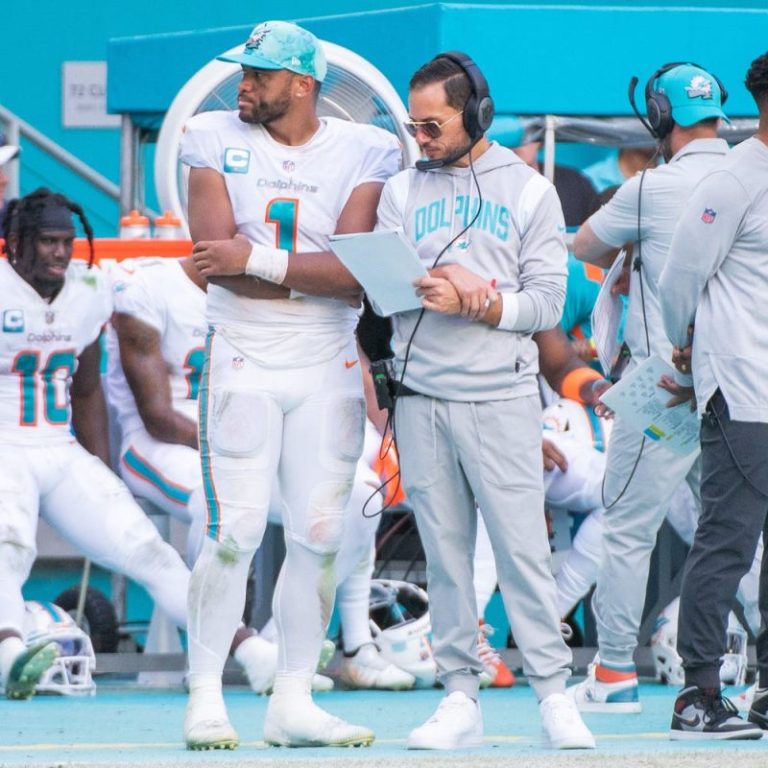It’s not often that Dolphins general manager Chris Grier pushes back with the force he used when asked if Tua Tagovailoa’s history with concussions doesn’t place him at a higher risk of suffering additional concussions.
Of all the issues confronting the Dolphins, it’s difficult to find one more critical not only to their future, but Tagovailoa’s. So any conclusions by Grier, the Dolphins’ medical team and Tagovailoa’s doctors must be reached with the gravity they deserve.
Don’t experts believe Tagovailoa is placing himself at increased risk by continuing to play?
“That is not a true statement,” Grier said.
Grier’s stance is supported not just by team and union doctors Tagovailoa has seen, but independent experts on concussions who have not treated the quarterback. Dr. Joseph Maroon said just because a football player has suffered a concussion, it doesn’t automatically place him at a greater risk of another.
Follow every game: Latest NFL Scores and Schedules
Maroon is a neurological consultant for the Pittsburgh Steelers and a clinical professor at the University of Pittsburgh. He’s also a member of the American Association of Neurological Surgeons, which on its website cites the University of Pittsburgh’s Brain Trauma Research Center in saying, “The risk of concussion in football is three to six times higher in players who have had a previous concussion.”
But there are many gray areas in the subject of concussions and for Maroon, this is one of them.
“My caveat: If the brain is not fully recovered, there’s a higher incidence,” he said.
That caveat is critical. The Dolphins’ season just ended, so Tagovailoa could go as long as September without being subjected to contact again.
“Given all offseason with no more contact, the odds are very, very positive that he would be returning next year,” Maroon said, adding he would not have any added concern for Tagovailoa’s well-being.
NFL newsletter: Sign up now to get football news delivered to your inbox
Maroon and Dr. Gillian Hotz, director of the University of Miami’s UHealth Concussion Program, stress the importance of giving the brain time to heal before returning to play. Tagovailoa suffered his most recent concussion on Christmas against Green Bay, after which coach Mike McDaniel repeatedly said decisions on when Tagovailoa could ramp up activity were solely up to doctors.
“They’re the experts in those fields and when they tell us that he’s ready to play … then we’ll press forward,” McDaniel said at his end-of-season news conference.
By then, Tagovailoa had sat out the Dolphins’ final three games, including a wild-card loss to Buffalo.
McDaniel and Grier say Tagovailoa will continue to be their franchise quarterback.
“I don’t think he’s any more prone than anyone else,” Grier said.
Chris Nowinski also on board in concussion assessment
Boynton Beach’s Chris Nowinski agreed. Nowinski is co-founder of the Concussion Legacy Foundation and questioned to ESPN whether Tagovailoa’s issues this past season may have been the result of rushing him back on the field — not durability. Writing on the CLF website, Nowinski said it’s unfair to say Tagovailoa is concussion-prone.
“A cluster of concussions, or even long-term symptoms, does not prevent a successful return or long career,” Nowinski wrote.
That’s not to suggest there’s no limit on the number of concussions a player can suffer before a doctor says it’s time to hang it up.
“I’ve advised many athletes to give up hockey as well as football,” Maroon said.
Top 10 Miami Dolphins offseason priorities | Schad
Before reaching that point, Maroon looks for lingering symptoms, issues with cognition and abnormalities on scans. He uses a before-and-after snapshot of an athlete’s cognitive skills, which is possible via the ImPACT test, which Maroon helped devise in the 1990s with doctors Mark Lovell and Michael Collins.
Taking about 20 minutes, ImPACT measures skills such as brain speed and ability to process information. It has been administered 23 million times, in all levels of competition. The ‘before’ baseline is established in preseason. Following a concussion, the test is repeated to help determine when to clear an athlete.
Tagovailoa became a national focal point when he was injured Sept. 25 vs. the Buffalo Bills. He returned to that game, with the Dolphins saying he’d suffered a back injury rather than a concussion. Four days later, during a prime-time game against Cincinnati, Tagovailoa suffered a concussion requiring a trip to the hospital.
The Dolphins’ problems were multiplied the following week when his replacement, Teddy Bridgewater, was judged to have stumbled by the NFL’s spotter high above. It disqualified Bridgewater from the game.
Here, too, might soon be another tool to take subjectivity out of the equation. Maroon sees potential for a mouthguard developed by Prevent Biometrics that measures the G-force of hits. Those statistics would be accessible to spotters via transmitter after every play. If experts agree on a maximum level of G-force before a concussion occurs, it could remove uncertainty from cases such as Bridgewater’s. The mouthguards are in use in rugby overseas.
“I think something like this is coming (to the NFL),” Maroon said.

